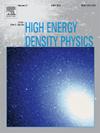Complex pseudo-partition functions in the Configurationally-Resolved Super-Transition-Array approach for radiative opacity
IF 0.9
3区 物理与天体物理
Q3 PHYSICS, FLUIDS & PLASMAS
引用次数: 0
Abstract
A few years ago, Kurzweil and Hazak developed the Configurationally Resolved Super-Transition-Arrays (CRSTA) method for the computation of hot-plasma radiative opacity. Their approach, based on a temporal integration, is an important refinement of the standard Super-Transition-Arrays (STA) approach, which enables one to recover the underlying structure of the STAs, made of unresolved transition arrays. The CRSTA formalism relies on the use of complex pseudo partition functions, depending on the considered one-electron jump. In this article, we find that, despite the imaginary part, the doubly-recursive relation which was introduced in the original STA method to avoid problems due to alternating-sign terms in partition functions, is still applicable, robust, efficient, and exempt of numerical instabilities. This was rather unexpected, in particular because of the occurrence of trigonometric functions, or Chebyshev polynomials, which can be either positive or negative. We also show that, in the complex case, the recursion relation can be presented in a form where the vector of real and imaginary parts at a given iteration is therefore obtained by a sum of the rotated previous ones.
构型分辨超过渡阵列辐射不透明度方法中的复伪配分函数
几年前,Kurzweil和Hazak开发了用于计算热等离子体辐射不透明度的构型分辨超跃迁阵列(CRSTA)方法。他们的方法基于时间集成,是标准超级转换阵列(STA)方法的重要改进,后者使人们能够恢复STA的底层结构,这些结构由未解析的转换阵列组成。CRSTA的形式依赖于复杂伪配分函数的使用,这取决于所考虑的单电子跃迁。在本文中,我们发现,尽管存在虚部,原始STA方法中为避免配分函数中符号交替项的问题而引入的双递推关系仍然是适用的、鲁棒的、有效的,并且没有数值不稳定性。这是相当出乎意料的,特别是因为三角函数的出现,或者切比雪夫多项式,它可以是正的也可以是负的。我们还证明,在复情况下,递归关系可以表示为这样一种形式,即在给定的迭代中,实部和虚部的向量因此是由旋转的前一个向量的和得到的。
本文章由计算机程序翻译,如有差异,请以英文原文为准。
求助全文
约1分钟内获得全文
求助全文
来源期刊

High Energy Density Physics
PHYSICS, FLUIDS & PLASMAS-
CiteScore
4.20
自引率
6.20%
发文量
13
审稿时长
6-12 weeks
期刊介绍:
High Energy Density Physics is an international journal covering original experimental and related theoretical work studying the physics of matter and radiation under extreme conditions. ''High energy density'' is understood to be an energy density exceeding about 1011 J/m3. The editors and the publisher are committed to provide this fast-growing community with a dedicated high quality channel to distribute their original findings.
Papers suitable for publication in this journal cover topics in both the warm and hot dense matter regimes, such as laboratory studies relevant to non-LTE kinetics at extreme conditions, planetary interiors, astrophysical phenomena, inertial fusion and includes studies of, for example, material properties and both stable and unstable hydrodynamics. Developments in associated theoretical areas, for example the modelling of strongly coupled, partially degenerate and relativistic plasmas, are also covered.
 求助内容:
求助内容: 应助结果提醒方式:
应助结果提醒方式:


